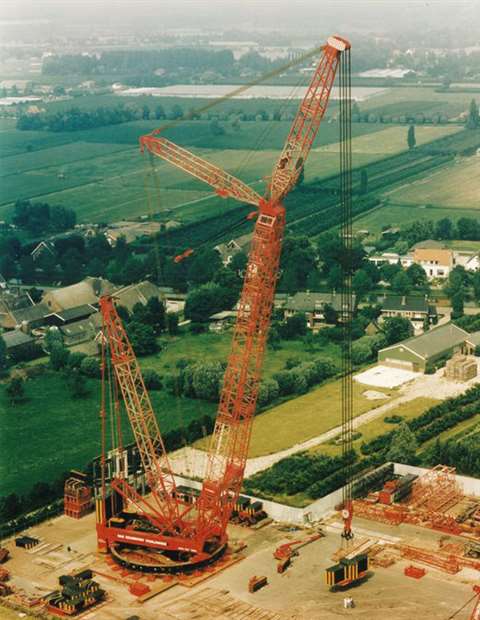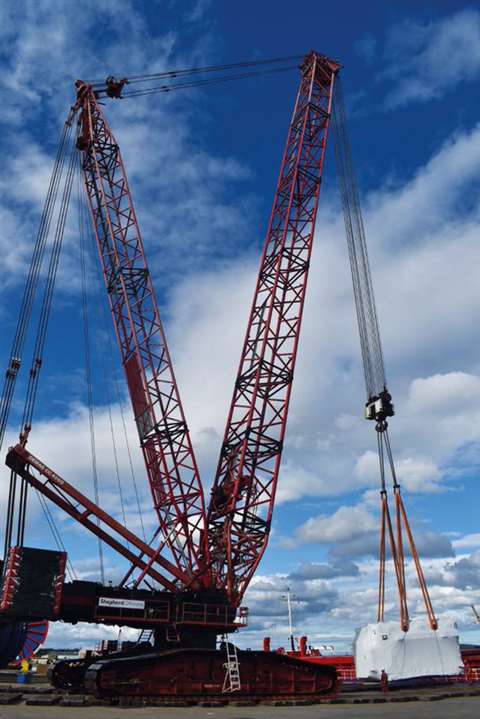Lifecycle of a crane: the Demag CC 4800
15 October 2021
Crawler cranes tend to last a long time, especially the good quality ones that are well looked after. This is the tale of a Demag CC 4800 through its already long and still ongoing life. ICST reports
In 1992, before the merger with Mammoet, Van Seumeren purchased four Demag CC 4800 lattice boom crawler cranes. It was a bold move because the 800 tonner was one of the world’s biggest cranes at that time.
The purchase proved to be a wise one and the cranes went on to lift in many countries and industries over the next three decades.
This story follows one of those four – still in use today – throughout its entire history.
 During earlier times the Demag CC 4800 in Van Seumeren colours, set up in Twin Ring configuration.
During earlier times the Demag CC 4800 in Van Seumeren colours, set up in Twin Ring configuration.
Dirk Knoester, senior advisor at Mammoet, remembers when the CC 4800 first arrived. “The purchase of the CC 4800 was a brave move for the business, as at the time we still mainly worked in the Netherlands and nearby European countries. In those days a crane with an 800 tonne capacity was not as common as it is today; it was a special piece of equipment.
“Fortunately, we recognised that there was growing demand for bigger lifts to keep the crane busy, particularly in developing nations where the energy industry was expanding. In hindsight, the CC 4800 really helped to announce the company on a global scale.”
Oil and gas projects
This meant that the CC 4800 was soon working around the world, primarily on a range of oil and gas projects. A key appeal was that the crane required relatively little space in which to operate, could be relocated on its tracks and drive with its load.
Among its early projects was Exxon’s Srirarcha Expansion Project in Thailand, where it lifted a range of large modules from a single position, helping to minimise the project’s construction time. In the early 1990s it was used alongside another CC 4800 to perform the tandem lift of an 800 tonne reactor in Venezuela; at the time a record for South America.
Wherever the crane travelled, so did its specialist crew. “Because the capacity of the CC 4800 was so rare, there was demand for it all over the world. Today, there are cranes with the same capacity in many countries, so you can avoid the time and expense of shipping such a big piece of equipment. That was simply not the case in the 1990s,” says Knoester.
“This meant that crews travelled across the world with the CC 4800, from Canada and South America to the Middle East and throughout Asia.”
Emerging trend for crane modularisation
As lifting bigger leads to more efficient project schedules, demand for the crane grew. So much so that by the mid-1990s even greater capacity was needed to accommodate the emerging trend for modularisation.
This led Mammoet to look beyond the crawler crane format, into how the CC 4800 could be upgraded for use as a ring crane with a capacity of more than 1,440 tonnes. The crane could then be used in both crawler and ring configuration on a project to give greater lifting options without the need for two cranes on site. Although modularised construction is now widespread in the oil and gas industry, this was not always the case.
Foster Wheeler, at Exxon’s Rotterdam facility in the Netherlands, used the ring configuration to lift seven items, including two columns weighing 606 tonnes and 759 tonnes, and then further smaller lifts in its standard crawler crane format.
Project managers who worked with the crane remember the advantages of working with this now traditional piece of equipment.
“We used to joke that all you really needed to make running repairs and fixes to the CC 4800 was a screwdriver and a hammer. This was a huge help when we were working out in remote locations such as Venezuela or Trinidad, where we would need to wait days if an engineer had to be flown in. Instead, we were able to deal with many problems ourselves, keeping the project on track.
“Although the CC 4800 was not easy to move – its crawlers weighed upwards of 90 tonnes each – it was a strong and reliable crane.”
Where was the CC 4800 used?
While the majority of the CC 4800’s work has been in the oil and gas sector, it has had an interesting working life beyond that industry. Knoester continues, “The CC 4800 helped move a steel mill from Germany to India, and a number of high-profile stadium builds. In 2006 it proved critical in building China’s centerpiece Beijing National Stadium, the ‘Bird’s Nest’, for the 2008 Olympic Games.”
Shortly after this project, following more than 20 years of service with Van Seumeren and Mammoet, the CC4800 found a new home with Shepherd Offshore in the UK where it is located on the quayside of Shepherd’s Newcastle upon Tyne facility.
 Still at work today, the Demag CC 4800 now owned by Shepherd Offshore in the UK.
Still at work today, the Demag CC 4800 now owned by Shepherd Offshore in the UK.
Terry Hall, assistant general manager at Shepherd Offshore comments, “Between 2016 and 2017, the CC 4800 hit a Shepherd Offshore record in assisting 133 heavy reel transfers between Offshore Technology Park and Neptune Energy Park in Newcastle upon Tyne. Since 2018, Shepherd Offshore has had more than 70 vessels berthed at Neptune Energy Park where the CC 4800 is based.
“During this time, it has handled a wide variety of loading and discharging projects and has successfully handled over 50,000 combined tonnes to and from vessels. It follows that our CC 4800 crane has been an invaluable cog in the Shepherd Offshore machine and a lynchpin of our Neptune Energy Park operations.
“The CC 4800 operations have been so successful that we have recently constructed even more quay space, to allow increased movements. Further, we have transformed our dry dock into a maritime test tank. Here, the CC 4800 is crucial in providing heavy and moveable lifts.
Mammoet recently supplied Shepherd with parts to repair the crane and keep it running. “Equipment maintenance is key to how we operate, and we were delighted to help find the CC 4800 a new home when it had reached the end of its working life at Mammoet,” comments Julian Alkemade at Mammoet Used Equipment.
STAY CONNECTED


Receive the information you need when you need it through our world-leading magazines, newsletters and daily briefings.




